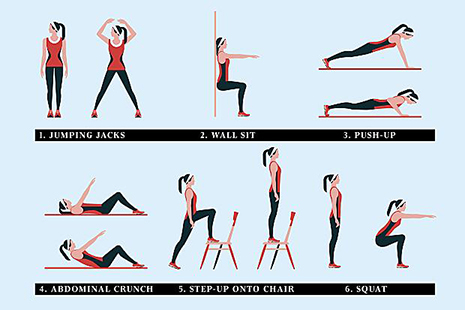Fitness used to be all about hours put in at the gym or miles covered in your trainers. Only those who dedicated themselves to suitably lengthy workouts could expect their body fat to plummet and their muscles to become exquisitely defined.
Tracey Anderson, trainer to Gwyneth Paltrow and Jennifer Lopez, said she expects devotees of her method to spend 90 minutes a day on her regime. Madonna set the bar higher, reportedly spending two hours a day with her trainer, Nicole Winhoffer. But now the question on even the most diligent exerciser`s lips is not how much should I do, but how little can I get away with?
This U-turn has been triggered by studies showing that you can make huge differences to your fitness in just a few minutes a day. The latest research published in the journal of the American College of Sports Medicine suggests just seven minutes of effort a day is enough. Already, high-intensity interval training (HIIT) – extremely intense bursts of activity followed by brief periods of recovery – has reached gym timetables in the form of classes such as GRIT and Puma HIIT.
But in their newly published findings, Chris Jordan and Brett Klika of the Human Performance Institute in Florida claim to have developed the ultimate abbreviated workout, a series of 12 exercises (see the illustrations in the gallery above) that in 7 gruelling minutes will produce results comparable to a run and a weights session combined. Their “high-intensity circuit training”, or HICT, is simple. It requires nothing more than a chair, a wall and your own body weight for resistance, plus old-fashioned brute effort for results: 30 seconds each of jumping jacks, push-ups, crunches and squats in quick succession with only a 10-second breather. As you get fitter, the seven-minute routine can be repeated 2-3 times, but if you are chronically time-crunched just once is sufficient. And as Jordan says, “It can be done anywhere.”
It sounds too good to be true. Yet, despite the lack of gadgetry and technology, it works. The combination of aerobic and resistance training has been shown time and again to “deliver numerous health benefits in much less time than traditional programs”. In some ways its growth is part of a backlash against the mind-body era of relatively unchallenging workouts (yoga, Pilates) that have dominated gyms in recent years. Researchers have long complained that these approaches fall short of meeting the physiological markers considered necessary for an exercise type to be labelled an all-round workout. Now there is an approach that ticks all the boxes.
“Sports scientists have known for some time that the demand on the cardiovascular system is related to the amount of muscle used during a workout and the intensity of the exercises that are performed,” says Professor John Brewer, director of sport at the University of Bedfordshire. “Work hard and the body will respond and adapt to the overload. So even if the duration is relatively short, the exercise will improve strength and core stability as well as aerobic fitness.”
It is also an impressive fat-burner. Because the exercises included in the seven-minute circuit recruit multiple large-muscle groups, they elicit a metabolism-boosting effect that can last for 72 hours. Researchers have observed an increased level of catecholamines and growth hormone in the blood during and after HICT. These speed up the loss of subcutaneous fatty tissue around the body much more effectively than traditional aerobic work or weight training.
There is a downside. It is tough and not something you can launch into after months of sofa-surfing. The authors advise anyone with hypertension or heart disease to skip the wall sit, plank and side plank. But if you are reasonably active, it is manageable, in an uncomfortable sort of way. And the pain is temporary.
Dr Michael Mosley is a convert after presenting a BBC programme on high-intensity workouts last year. He has recently added the seven-minute circuit to his daily regime in addition to a three-minute HIIT workout on alternate days. “I find the seven minutes easier than the three-minute HIIT session, which involves repeated bouts of 20 seconds of intense cycling,” he says. “You can`t push yourself quite as hard when you are doing press-ups or leaning against a wall as you can when going flat out on a gut-busting bicycle sprint. The good thing about intense exercise is that it takes the edge off my appetite, so I`m not tempted to nibble. Though I do have to lie down to recover.”
Fit in 2 minutes
Researchers at the University of Birmingham and Liverpool John Moores University have been looking at the effects of SIT (sprint interval training) on health and, in a report published in The Journal of Physiology in February, showed that as few as four 30-second sprints on indoor bikes, interspersed with 4½ minutes` recovery, can produce significant improvements in health.
Pros Studies suggest that SIT training can prevent blood-vessel disease, hypertension, diabetes and most of the other ageing and obesity-related chronic diseases. Indeed, three weekly sessions of SIT over six weeks produced comparable results to five weekly 40 to 60-minute sessions of traditional steady-paced endurance training on indoor bikes.
Cons Researchers at Liverpool John Moores University say that owing to the very high workload of the sprints in SIT workouts, the method is only really suitable for young, fit people.
Fit in 3 minutes
Devised by Professor Jamie Timmons, chairman of systems biology at Loughborough University, and based on HIIT, this is an approach that involves getting on an exercise bike, warming up with gentle cycling for a couple of minutes, then going flat out for 20 seconds. Next, a couple more minutes` gentle cycling to catch your breath, then another 20 seconds at full speed. Finish with another couple of minutes` gentle cycling, then a final 20 seconds flat out. Repeat three times a week so that you perform a total of nine 20-second intervals (or six 30-second intervals if you prefer).
Pros In clinical trials, Timmons has shown that his approach helps to improve insulin sensitivity – important for keeping blood sugar or glucose stable – by up to 24 per cent in two weeks. As a result, it can help to offset type 2 diabetes and will also keep you trim. Other studies on a similar HIIT approach published in Medicine & Science in Sports & Exercise found a 35 per cent improvement in insulin sensitivity after only two weeks. Studies have also shown that HIIT engages 80 per cent of the body`s muscles, compared with up to 40 per cent during gentle jogging or cycling. A pilot study currently underway in the sports centre at the University of Birmingham has also shown that previously sedentary individuals in the age range of 25-60 also find HIIT much more enjoyable than endurance training and report that it has a more positive effect on mood and feelings of wellbeing.
Cons It`s tough. If you haven`t pushed yourself when exercising for a while, it is better to start with a more moderate introduction to interval training such as the ten-minute workout below.
Fit in 4 minutes
Last month, Norwegian researchers published a study in the online journal Plos One that showed a single four-minute run at a hard pace performed three times a week was enough to boost health and fitness.
Pros At the end of the ten-week Norwegian trial, subjects had improved their endurance capacity by 10 per cent or more, lowered their blood pressure and had better blood-sugar control. A single four-minute run at 90 per cent maximum effort was as effective as four four-minute runs with a three-minute slow-walk recovery.
Cons Few of the subjects lost much body fat. “This is not a weight-loss program,” warns Dr Arnt Erik Tjonna, a researcher from the Norwegian University of Science and Technology. Rather, it offers “a kick-start for better fitness” when time is short.
Fit in 8 minutes
American personal trainer Jorge Cruise is gaining a reputation as a fitness guru for the time-deprived. His bestselling books, including the 8 Minutes in the Morning series and The 3-hour Diet, promise to guide you to weight loss in a matter of minutes.
Pros Cruise`s daily eight-minute workout is based on the theory that weight training builds muscle and that the more muscle you develop, the more fat you`ll burn. It consists of doing four sets each of two different strength-training exercises (such as push-ups and bicep curls with dumbbells), targeting specific body parts, six days a week. After a brief warm-up, you do one set of 12 repetitions of the first of the day`s exercises, then immediately follow with 12 reps of the second. Repeat the cycle three more times and it`s over. Cruise says that if you also follow his diet advice you can lose 1kg a week, boost your metabolism and improve muscle tone.
Cons Even Cruise admits that the approach “is exclusively for weight loss”. If you are seeking fitness gains – especially aerobic improvements – it`s not the approach for you. Indeed, additional power walking is recommended to boost cardiovascular fitness.
More about:
















































